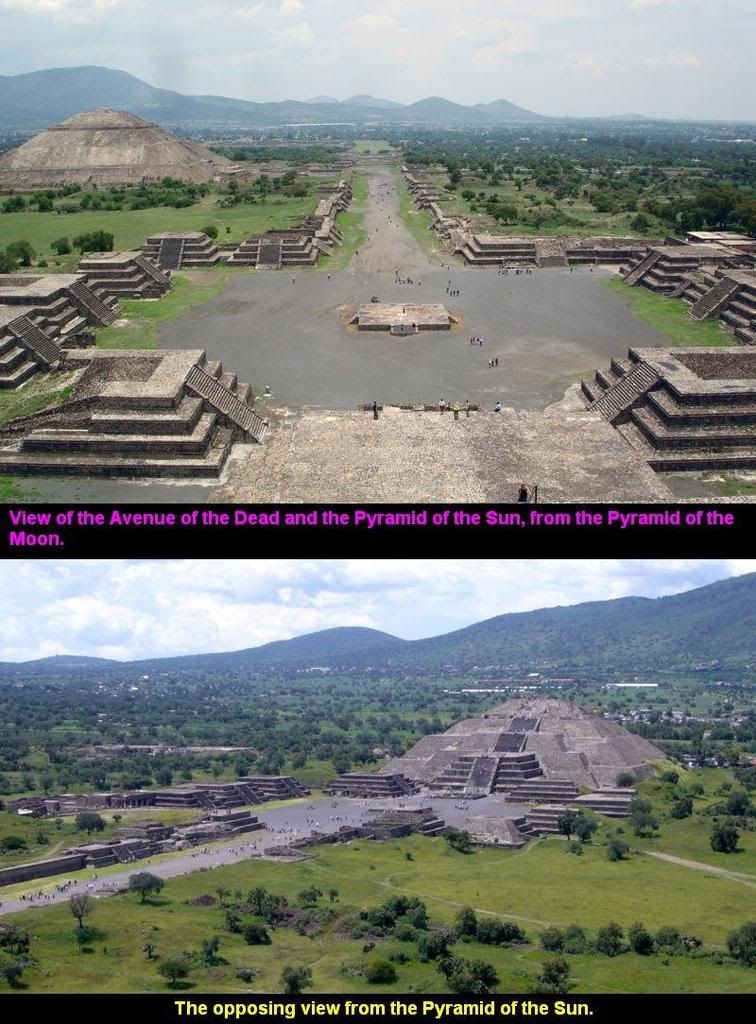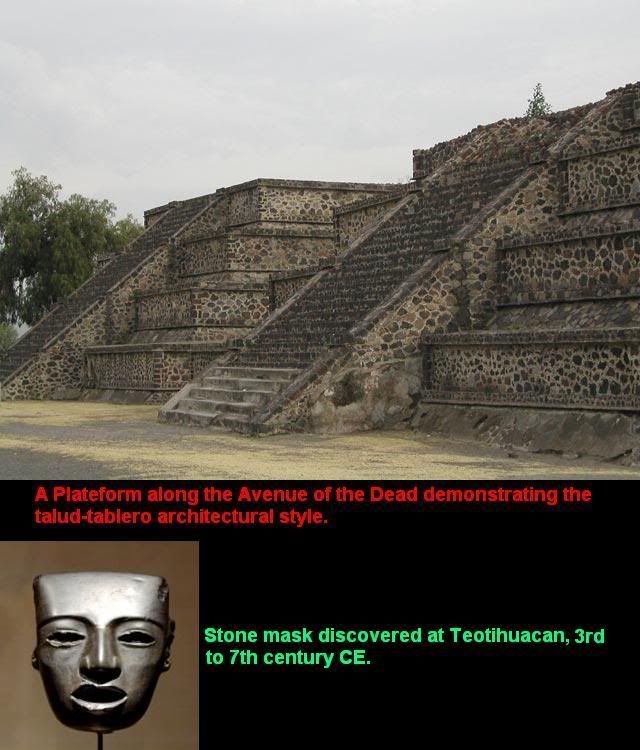Post by bluefedish on Feb 5, 2008 15:31:18 GMT -5
Teotihuacán (teotiwa'kan) was, at its height in the first half of the 1st millenium CE, the largest pre-Columbain city in the Americas. The civilization and cultural complex associated with the site is also referred to as Teotihuacan. Its influence spread throughout Mesoamerica; evidence of Teotihuacano presence, if not outright political and economic control, can be seen at numerous sites in Veracruz and the Maya region.
The city was located in what is now the San Juan Teotihuacan municipality in the State of Mexico, Mexico, approximately 24.8 miles northeast of Mexico City. It covers a total surface area of 83 km and was made a UNESCO World Heritage Site in 1987.
The name Teotihuacán was given by the Nahuatl-speaking Aztec centuries after the fall of the city. The term has been glossed as 'birthplace of the gods', reflecting Nahua creation myths that took place in Teotihacan. Another translation was offered by Thelma Sullivan, who interprets the name as "place of those who have the road of the gods."
The original name of the city is unknown, but it appears in hieroglyphic texts from the Maya region as 'puh', or "Place of Reeds". This suggests that the Maya understood Teotihuacan as a 'Place of Reeds' similar to other Central Mexican settlements that took the name 'Tollan', such as Tula-Hidalgo and Cholula. This naming convention led to much confusion in the early 20th century as scholars debated whether Teotihuacan or Tul-Hidalgo was the Tollan described by 16th century chronicles. It now seems clear that 'Tollan' may be understood as a generic term applied to any large settlement, rather like the modern expression "the Big Smoke". In the Mesoamerican concept of urbanism, Tollan and other language equivalents serve as a metaphor, linking the bundles of reeds and rushes that formed part of the lacustrine environment of the Valley of Mexico and the large gathering of people in a city.
History
The early history of Teotihuacán is quite mysterious, and the origin of its founders is debated. For many years, archaeologists believed it was built by the Toltec people, an early Mexican civilization. This belief was based on Aztec writings which attributed the site to the Toltecs. However, the Nahuatl word "Toltec" means "great craftsman" and may not always refer to the Toltec civilization. Also, Teotihuacán predates the Toltec civilization, ruling them out as the city's founders. Other scholars have put forth the Totonac people as the founders of Teotihuacán, and the debate continues to this day. There is evidence that at least some of the people living in Teotihuacán came from areas influenced by the Teotihuacano civilization, including the Zapotec, Mixtec and Maya peoples. The culture and architecture of Teotihuacán was influenced by the Olmec people, who are considered to be the "mother civilization" of Mesoamerica. The earliest buildings at Teotihuacán date to about 200 BCE, and the largest pyramid, the Pyramid of the Sun, was completed by 100 CE.
Teotihuacano culture
There is archaeological evidence that Teotihuacan was a multi-ethnic city, with distinct Zapotec, Mixtec, Maya and what seem to be Nahua quarters. The Totonacs have always maintained that they were the ones who built it, a story that was corroborated later by the Aztecs.
The religion of Teotihuacán is similar to those of other Mesoamerican cultures. many of the same gods were worshiped, including the Feathered Serpent and The Rain God. Teotihuacán was a major religious center, and the priests probably had a great deal of political power. As with other Mesoamerican cultures, Teotihuacános practiced human sacrifice. Human bodies and animal sacrifices have been found during excavations of the pyramids; it's believed that when the buildings were expanded, sacrifices were made to dedicate the new building. The victims were probably enemy warriors captured in battle and then brought to the city to be ritually sacrificed so the city could prosper. Some were decapitated, some had their hearts removed, others were killed by being hit several times over the head and some wer even buried alive. Animals that were considered sacred and represented mythical powers and military might were also buried alive but imprisoned in cages: cougars, wolves, eagles, falcons, owls, and even venomous snakes.
The city's broad central avenue, called "Avenue of the Dead" (a translation from its Nahuatl name 'Miccaotli'), is flanked by impressive ceremonial architecture, including the immense Pyramid of the Sun (2nd larges in the New World after the Great Pyramid of Cholula) and the Pyramid of the Mood. Along the Avenue of the Dead are many smaller talud-tablero platforms. The Aztecs believed they were tombs, inspiring the name of the avenue. Now they are known to be ceremonial platforms that were topped with temples. Further down the Avenue of the Dead is the area known as the Citadel, containing the ruined Temple of the Feathered Serpent. This area was a large plaza surrounded by temples that formed the religious and political center of the city. The name "Citadel" was given to it by the Spanish, who believed it was a fort. Many of the rich and powerful Teotihuacános lived in Palaces near the temples, the largest of these covering more than 3300 m². Most of the common people lived in large apartment buildings spread across the city. Many of the buildings contained workshops that produced pottery and other goods.


Selected Source:
en.wikipedia.org/wiki/Teotihuac%C3%A1n
The city was located in what is now the San Juan Teotihuacan municipality in the State of Mexico, Mexico, approximately 24.8 miles northeast of Mexico City. It covers a total surface area of 83 km and was made a UNESCO World Heritage Site in 1987.
The name Teotihuacán was given by the Nahuatl-speaking Aztec centuries after the fall of the city. The term has been glossed as 'birthplace of the gods', reflecting Nahua creation myths that took place in Teotihacan. Another translation was offered by Thelma Sullivan, who interprets the name as "place of those who have the road of the gods."
The original name of the city is unknown, but it appears in hieroglyphic texts from the Maya region as 'puh', or "Place of Reeds". This suggests that the Maya understood Teotihuacan as a 'Place of Reeds' similar to other Central Mexican settlements that took the name 'Tollan', such as Tula-Hidalgo and Cholula. This naming convention led to much confusion in the early 20th century as scholars debated whether Teotihuacan or Tul-Hidalgo was the Tollan described by 16th century chronicles. It now seems clear that 'Tollan' may be understood as a generic term applied to any large settlement, rather like the modern expression "the Big Smoke". In the Mesoamerican concept of urbanism, Tollan and other language equivalents serve as a metaphor, linking the bundles of reeds and rushes that formed part of the lacustrine environment of the Valley of Mexico and the large gathering of people in a city.
History
The early history of Teotihuacán is quite mysterious, and the origin of its founders is debated. For many years, archaeologists believed it was built by the Toltec people, an early Mexican civilization. This belief was based on Aztec writings which attributed the site to the Toltecs. However, the Nahuatl word "Toltec" means "great craftsman" and may not always refer to the Toltec civilization. Also, Teotihuacán predates the Toltec civilization, ruling them out as the city's founders. Other scholars have put forth the Totonac people as the founders of Teotihuacán, and the debate continues to this day. There is evidence that at least some of the people living in Teotihuacán came from areas influenced by the Teotihuacano civilization, including the Zapotec, Mixtec and Maya peoples. The culture and architecture of Teotihuacán was influenced by the Olmec people, who are considered to be the "mother civilization" of Mesoamerica. The earliest buildings at Teotihuacán date to about 200 BCE, and the largest pyramid, the Pyramid of the Sun, was completed by 100 CE.
Teotihuacano culture
There is archaeological evidence that Teotihuacan was a multi-ethnic city, with distinct Zapotec, Mixtec, Maya and what seem to be Nahua quarters. The Totonacs have always maintained that they were the ones who built it, a story that was corroborated later by the Aztecs.
The religion of Teotihuacán is similar to those of other Mesoamerican cultures. many of the same gods were worshiped, including the Feathered Serpent and The Rain God. Teotihuacán was a major religious center, and the priests probably had a great deal of political power. As with other Mesoamerican cultures, Teotihuacános practiced human sacrifice. Human bodies and animal sacrifices have been found during excavations of the pyramids; it's believed that when the buildings were expanded, sacrifices were made to dedicate the new building. The victims were probably enemy warriors captured in battle and then brought to the city to be ritually sacrificed so the city could prosper. Some were decapitated, some had their hearts removed, others were killed by being hit several times over the head and some wer even buried alive. Animals that were considered sacred and represented mythical powers and military might were also buried alive but imprisoned in cages: cougars, wolves, eagles, falcons, owls, and even venomous snakes.
The city's broad central avenue, called "Avenue of the Dead" (a translation from its Nahuatl name 'Miccaotli'), is flanked by impressive ceremonial architecture, including the immense Pyramid of the Sun (2nd larges in the New World after the Great Pyramid of Cholula) and the Pyramid of the Mood. Along the Avenue of the Dead are many smaller talud-tablero platforms. The Aztecs believed they were tombs, inspiring the name of the avenue. Now they are known to be ceremonial platforms that were topped with temples. Further down the Avenue of the Dead is the area known as the Citadel, containing the ruined Temple of the Feathered Serpent. This area was a large plaza surrounded by temples that formed the religious and political center of the city. The name "Citadel" was given to it by the Spanish, who believed it was a fort. Many of the rich and powerful Teotihuacános lived in Palaces near the temples, the largest of these covering more than 3300 m². Most of the common people lived in large apartment buildings spread across the city. Many of the buildings contained workshops that produced pottery and other goods.


Selected Source:
en.wikipedia.org/wiki/Teotihuac%C3%A1n



